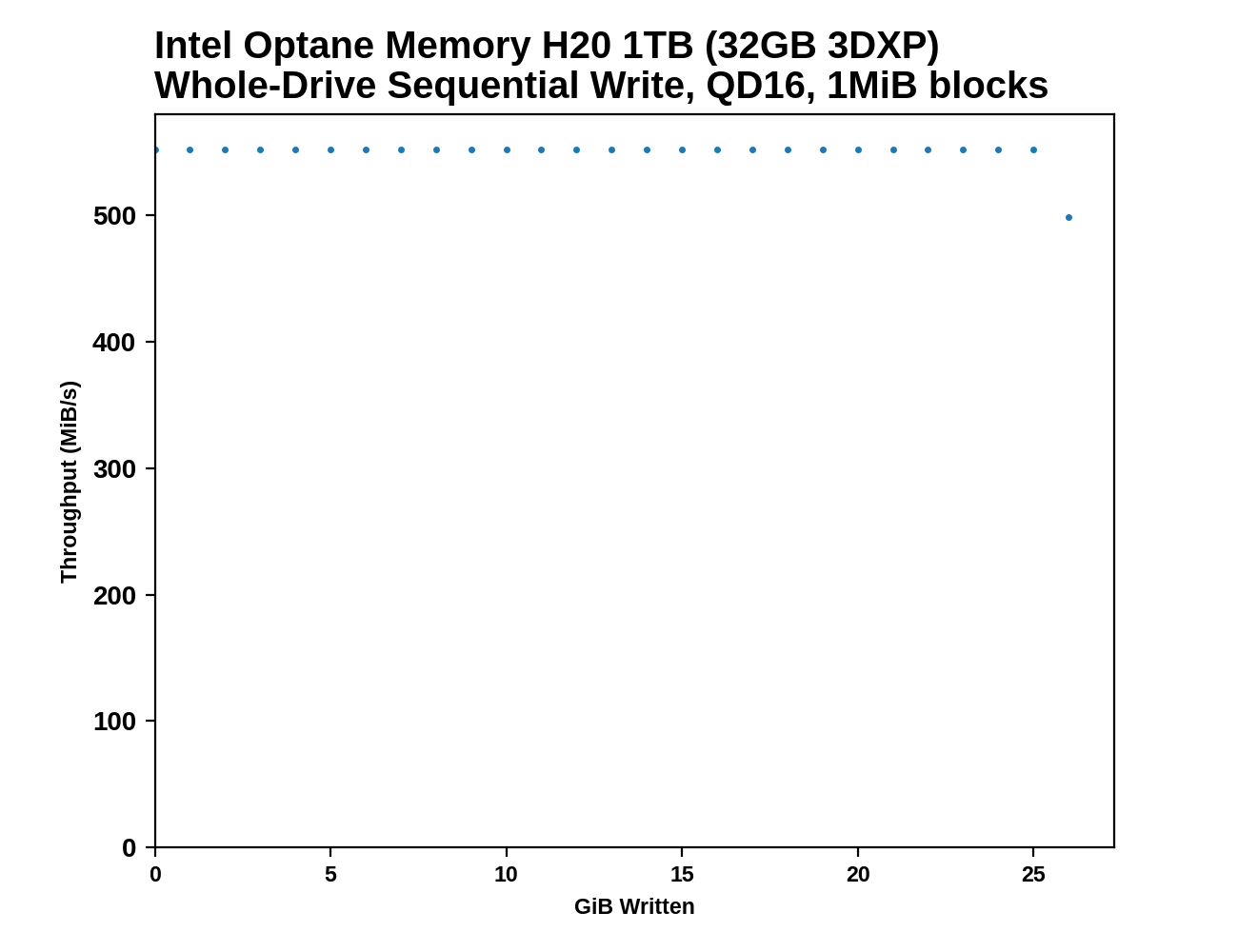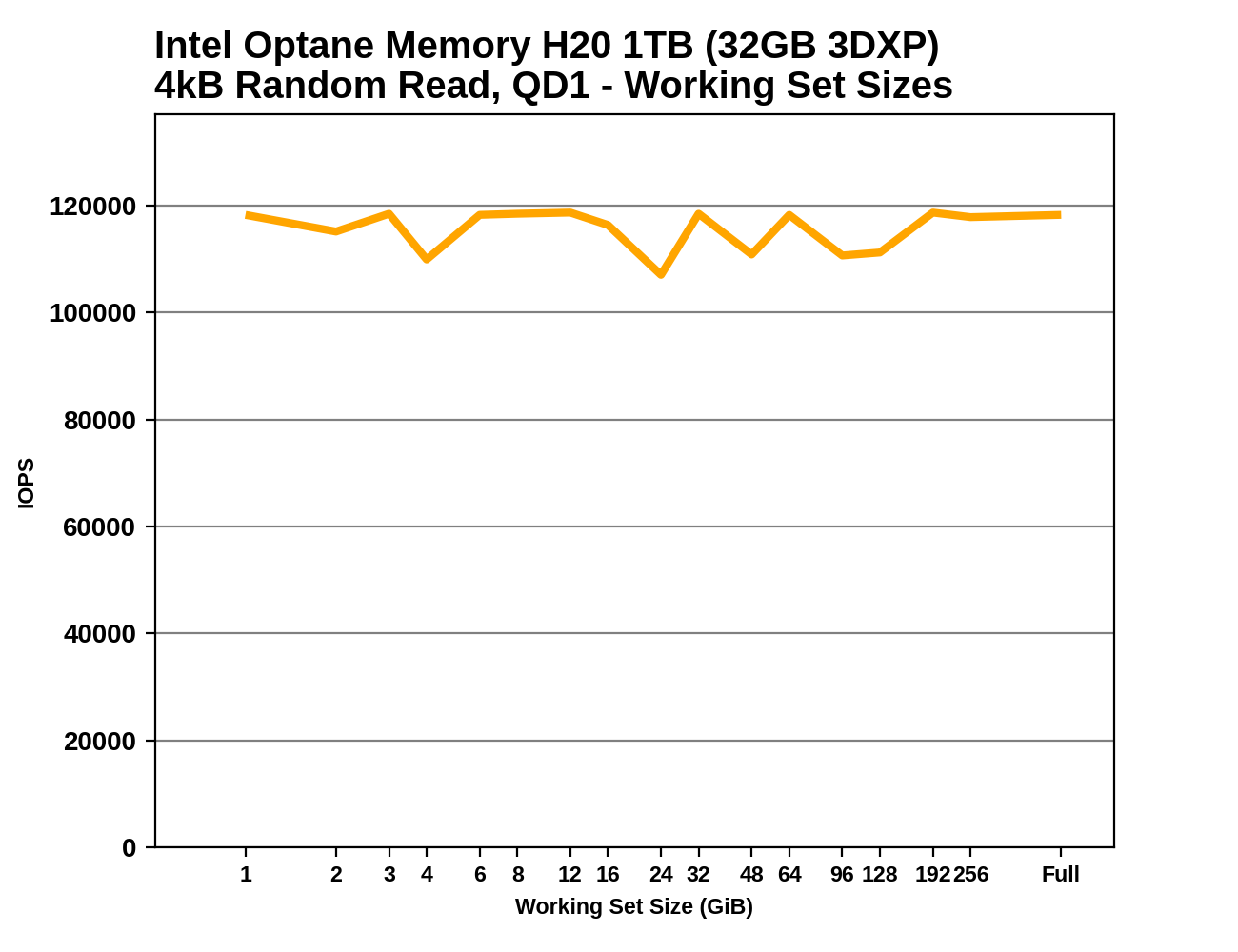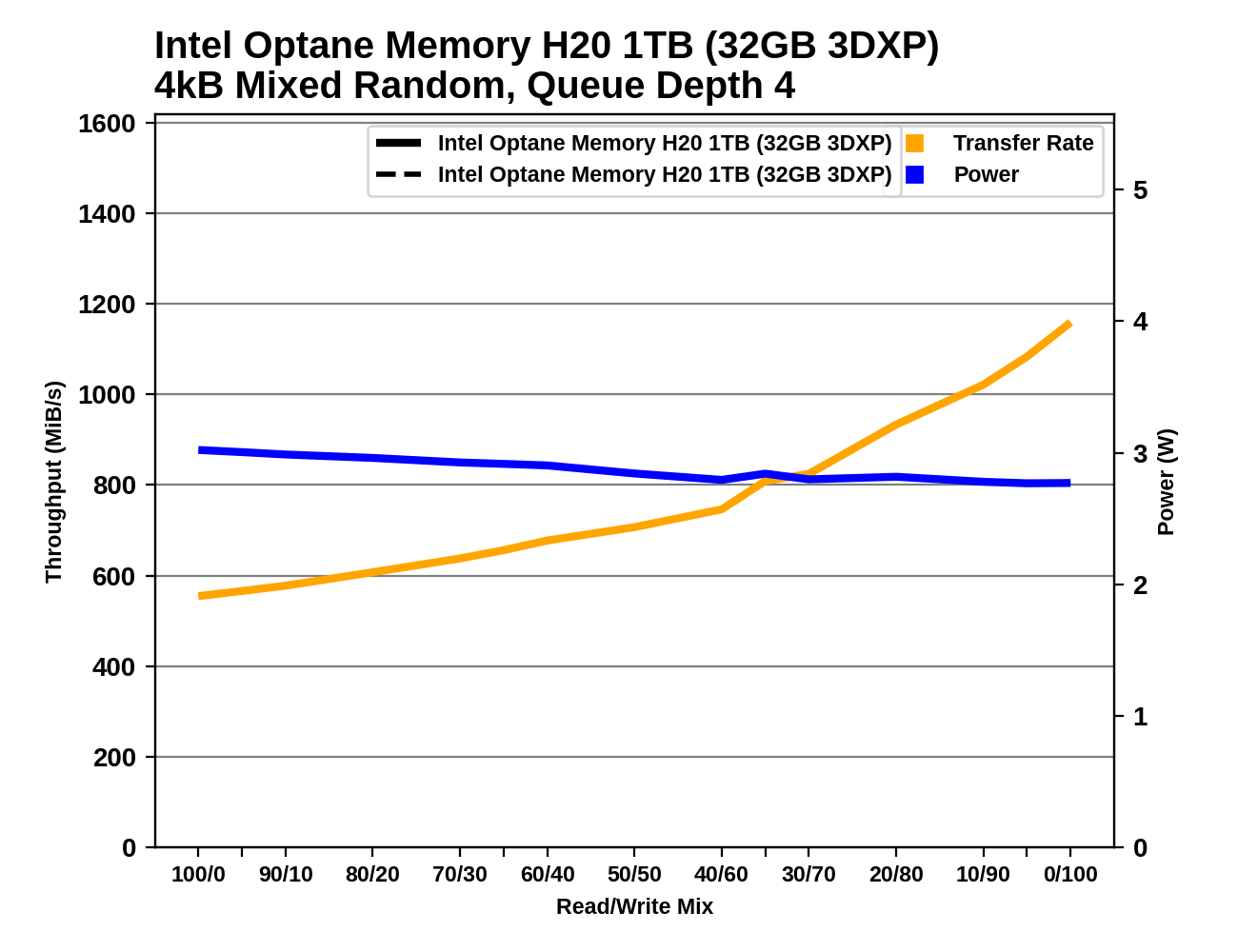Caching And Tiering: Intel Optane Memory H20 and Enmotus FuzeDrive SSD Reviewed
by Billy Tallis on May 18, 2021 2:00 PM EST- Posted in
- SSDs
- Storage
- Intel
- SSD Caching
- 3D XPoint
- Optane
- Optane Memory
- Tiger Lake
Our suite of Linux-based synthetic tests cannot directly measure how the Intel Optane Memory H20 or Enmotus FuzeDrive SSD behave when used with their respective caching or tiering software, but we can investigate how the individual components of those storage systems perform in isolation. The tests on this page are all conducted on our usual AMD Ryzen testbed.
Advanced Synthetic Tests
Our benchmark suite includes a variety of tests that are less about replicating any real-world IO patterns, and more about exposing the inner workings of a drive with narrowly-focused tests. Many of these tests will show exaggerated differences between drives, and for the most part that should not be taken as a sign that one drive will be drastically faster for real-world usage. These tests are about satisfying curiosity, and are not good measures of overall drive performance. For more details, please see the overview of our 2021 Consumer SSD Benchmark Suite.
Whole-Drive Fill
 |
|||||||||
| Pass 1 | |||||||||
| Pass 2 | |||||||||
As expected, we see fairly steady write performance from the Intel Optane devices, including on the second write pass—but the total throughput is still quite low compared to NAND SSDs. The SLC portion of the Enmotus FuzeDrive SSD has similar performance consistency, but competitive throughput. The QLC portion of that drive does have the typical drive-managed SLC cache that starts out with a capacity of about 333 GB when this section of the drive is empty, and shrinks down to about 19 GB for the second pass when the drive is full.
 |
|||||||||
| Average Throughput for last 16 GB | Overall Average Throughput | ||||||||
The SLC portion of the Enmotus FuzeDrive SSD is naturally far faster for the overall fill process than the drives that run out of SLC and slow down part way through. The Optane devices aren't quite in a "slow and steady wins the race" situation against the traditional NAND SSDs, but the Optane Memory H20's cache device is at least faster than the post-cache performance of the QLC drives and the DRAMless Samsung 980.
Working Set Size
 |
|||||||||
There's a bit of variability in the random read latency of the Optane cache on the Optane Memory H20, but it's so much faster than the NAND devices that a bit of inconsistency hardly matters. We're just seeing noise that only shows up at this scale and is insignificant at NAND speeds. The SLC slice of the FuzeDrive SSD is faster than any of the other NAND drives, but it's a narrow lead. These fast devices naturally do not show any of the performance drop-off that comes from having insufficient DRAM: the Optane caches don't need it in the first place, and the SLC portion of the FuzeDrive SSD is small enough to be managed with a fraction of the drive's DRAM.
Performance vs Block Size
 |
|||||||||
| Random Read | |||||||||
| Random Write | |||||||||
| Sequential Read | |||||||||
| Sequential Write | |||||||||
The Optane cache on the H20 behaves almost exactly like previous Optane Memory devices, except that it has acquired a strong dislike for sequential writes one 512B sector at a time. We often see sub-4kB sequential writes performing badly on NAND devices because the flash translation layer operates with 4kB granularity, so perhaps Intel has switched something in this Optane module to operate with 1kB granularity and it now needs to perform a read-modify-write cycle to handle this case. (The lack of a similar performance drop for random writes is a bit of a puzzle.)
The SLC portion of the Enmotus FuzeDrive SSD shows similar overall behavior to other Phison-based NAND drives, albeit with generally higher performance.
Mixed IO Performance
For details on our mixed IO tests, please see the overview of our 2021 Consumer SSD Benchmark Suite.
 |
|||||||||
| Mixed Random IO | Throughput | Power | Efficiency | ||||||
| Mixed Sequential IO | Throughput | Power | Efficiency | ||||||
The Intel Optane devices handle the mixed random IO test better than any of the NAND drives, and the Optane Memory H20's speed improvements over the H10 bring it up to the level of the larger 118GB Optane SSD 800P. The SLC portion of the Enmotus FuzeDrive SSD performs comparably to a decent 1TB TLC drive with SLC cache.
On the mixed sequential IO test, the Optane devices are far slower than the NAND devices, and the SLC has no real advantage either. A fast controller and lots of NAND is the best recipe for high performance on this test.
 |
|||||||||
| Mixed Random IO | |||||||||
| Mixed Sequential IO | |||||||||
The Optane devices show completely different performance trends from the NAND devices on the mixed random IO test: the Optane drives speed up significantly as the workload gets more write-heavy, while the NAND drives have flat or declining performance. On the mixed sequential IO test, the Optane behavior is a bit more normal, albeit with very low-end performance.










45 Comments
View All Comments
haukionkannel - Wednesday, May 19, 2021 - link
All ”highend” ssd are soon gonna be qlc and middle and low range will go plc…So just wait the things to get even worse!
;)
edzieba - Friday, May 21, 2021 - link
Ah, the QLC brigade is here, with the same Dire Warnings Of Horrible Doom that previously fell flat for MLC and TLC, but THIS time will totally come true (or we'll cross out the Q and put P and protest against the evils of PLC next year!).kepstin - Tuesday, May 18, 2021 - link
If you were to somehow get one of these Intel drives and plug it into an unsupported system, will it just show up as 2 separate NVMe drives? Would you be able to use it with hardware agnostic caching solutions like PrimoCache on Windows or bcache/dm-cache on Linux?drexnx - Tuesday, May 18, 2021 - link
sounds like the host system just sees it as a 32gb optane SSDBilly Tallis - Tuesday, May 18, 2021 - link
Depends on what the host system is, and what kind of slot. Only the supported Intel systems can initialize PCIe links to both sides. For the H10 review, I made a chart of all the systems I'd tried: https://www.anandtech.com/show/14249/the-intel-opt...If the slot is only PCIe x1 or x2, you get the NAND. If it's x4, you might get the NAND or you might get the 3DXP.
kepstin - Tuesday, May 18, 2021 - link
Ah, so there's no PCIe bridge/switch on the device itself? I guess they're relying on the upstream bridge of the M.2 slot supporting bifurcating the 4× link into 2×/2×.Billy Tallis - Tuesday, May 18, 2021 - link
Correct. The H10 and H20 rely on upstream port bifurcation support. I think there's also a proprietary element to it, but bifurcation down to x2 links is less widely supported than bifurcation down to x4 links anyways.A PCIe switch would have been nice, but wouldn't fit. And this product line isn't important enough for Intel to make a big new custom ASIC for, either a SSD controller that can speak to both 3DXP and QLC, or adding PCIe switch/passthrough support to one of the two controllers.
Kurosaki - Tuesday, May 18, 2021 - link
Maybe next gen then?...Tomatotech - Tuesday, May 18, 2021 - link
The H20 is just a placeholder while the Optane team treads water and begs the rest of Intel to let them release a proper drive. This H20 looks like a greyhound with bricks tied to its neck. Absolutely lovely latency and random 4K performance would be a credit to any high-end workstation. But it's crippled by a shit implementation.Apple was doing tiered drive storage nearly 10 years ago with their Fusion drives, and as the Enmotus tiered drive shows, it can do amazing things. This is how the H20 should be set up.
I say the H20 is treading water; it should be on PCIe 4.0 but because of Intel's shenanigans with PCIe 4.0 the Optane team are crippled and can't release this drive with the backing support it needs. Hopefully the next model, maybe the H30, will have PCIe 4.0 and then it'll finally be a decent overall drive.
Probably not, given the sad history of Intel shooting Optane in the foot. They could have released this drive several years ago, and it would have been excellent then, but normal NAND drives are improving all the time and it's just too little, too late.
Spunjji - Wednesday, May 19, 2021 - link
"a greyhound with bricks tied to its neck" - succinct. 👍